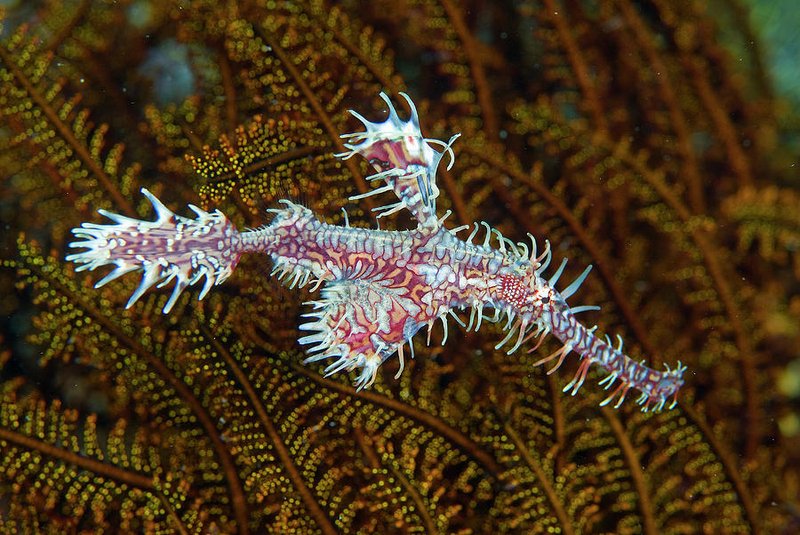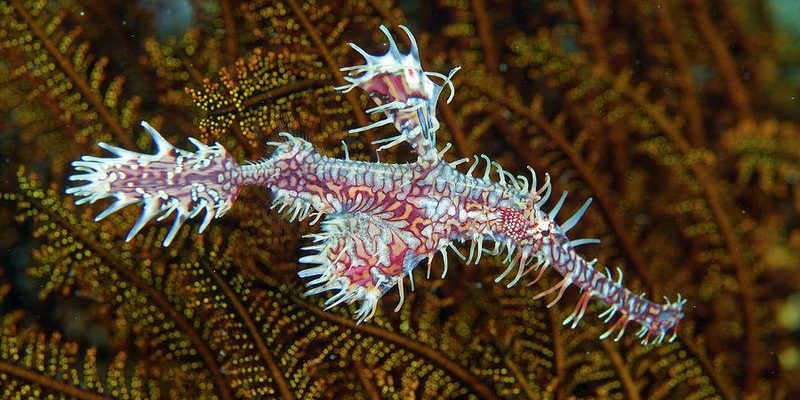
Have you ever seen a creature that looks like a very long fish but also a tiny snake? That’s the pipefish for you! These fascinating marine animals belong to the family Syngnathidae, which includes seahorses as well. Pipefish have elongated bodies and long snouts, giving them a unique appearance that makes them stand out in the underwater world. You might be surprised to learn just how diverse and interesting these little creatures can be.
Despite their delicate looks, pipefish have adapted well to various marine environments. They often camouflage themselves among seagrass, coral reefs, and mangroves, making them masters of disguise. Their unique morphology isn’t just for show; it helps them survive in habitats where they can avoid predators while hunting for food. If you’re curious about these amazing fish, stick around as we dive deeper into their lives, behaviors, and habitats.
Physical Characteristics of Pipefish
Pipefish come in various shapes, sizes, and colors, but they all share a few common features. The most notable is their elongated bodies that can reach anywhere from a few inches to about a foot long, depending on the species. This elongated shape helps them navigate through tight spaces in their environments, similar to how an eel moves. Their eyes are often positioned on top of their heads, giving them a panoramic view of their surroundings.
What’s really cool is that their bodies are covered with bony plates instead of scales, which add a layer of protection. You might think of it as wearing a suit of armor, allowing them to be more resilient in their often rocky or rough habitats. Pipefish are also known for their intricate colors and patterns. Some are bright and vibrant, while others prefer to blend in with their surroundings. This color variation not only makes them beautiful but also helps with camouflage, making it harder for predators to spot them.
Habitat of Pipefish
Pipefish are versatile when it comes to habitats. They are typically found in shallow waters, usually in coastal areas such as estuaries, coral reefs, and seagrass beds. These environments provide both the food sources and shelter they need to thrive. Imagine them weaving in and out of seagrass, blending in seamlessly with their surroundings. It’s almost like they’re playing hide-and-seek with the world around them!
These fish are distributed across various oceans and seas, including the Atlantic, Pacific, and Indian Oceans. Depending on the species, some prefer warm tropical waters, while others can tolerate cooler temperatures. When considering their habitat, water quality plays a crucial role. Pipefish are sensitive to pollution, and healthy, clean environments are pivotal for their survival. Without these safe havens, their populations could dwindle, making conservation efforts essential.
Diet and Feeding Habits
Pipefish are carnivorous and primarily feed on small crustaceans, plankton, and tiny fish. Their long, tube-like snouts are perfectly adapted for sucking up food—imagine using a straw to sip your favorite drink. They ambush their prey, lying in wait until they’re close enough to strike. It’s a very efficient way to hunt, especially when you’re trying to avoid becoming someone else’s meal!
One interesting thing about their feeding habits is that they have no teeth. Instead, they rely on suction to draw in their food, which can be quite effective given their specialized anatomy. Pipefish tend to feed slowly and methodically, ensuring they make the most out of every meal. Knowing this helps you appreciate just how unique their feeding strategy is compared to that of other fish.
Reproduction and Life Cycle
Pipefish have a particularly fascinating reproductive process. Like their close relatives, the seahorses, male pipefish play a unique role in caring for their young. The female will transfer her eggs to the male’s brooding pouch, where he fertilizes and carries them until they hatch. It’s a pretty sweet deal for the males—imagine carrying your baby siblings in a little pouch while they grow up!
Eggs can take anywhere from a few weeks to several months to hatch, depending on the species and environmental conditions. After that, the baby pipefish are released and must fend for themselves right away. They’re pretty much mini versions of their parents, instantly starting their journey in the vast ocean. The survival rate for young pipefish can be low, as they face many dangers, including predators, so their early days are crucial.
Conservation Status
Many pipefish species are currently facing threats primarily due to habitat loss, pollution, and overfishing. As coastal environments continue to be developed, the delicate ecosystems pipefish rely on are increasingly at risk. Additionally, their unique shapes and colors have made them targets for the aquarium trade, further impacting their populations. Conservation efforts are needed to protect these intriguing creatures and their habitats.
Organizations around the world are working to raise awareness about the plight of pipefish and their environments. Protecting coastal habitats means ensuring the survival of not just pipefish but various marine life that depend on healthy ecosystems. Joining local conservation efforts or supporting marine preservation initiatives can make a difference in these animals’ futures.
Fun Facts About Pipefish
- Unique Defense Mechanism: When threatened, some pipefish can change color to blend in better with their surroundings.
- Social Creatures: Pipefish often prefer to live in groups, which can provide added safety from predators.
- Long Lifespan: In captivity, some pipefish species can live for over five years!
- Variety of Species: There are over 200 species of pipefish, each with unique characteristics and habitats.
- Camouflage Experts: Their elongated bodies make them nearly invisible when resting among seagrass or coral.
FAQ
What is the typical size of a pipefish?
Pipefish can vary significantly in size depending on the species. Most are relatively small, typically ranging from 2 to 12 inches long. Some species, like the slender pipefish, can be on the smaller end, while others can grow up to a foot in length. Their elongated bodies contribute to their unique and fascinating shapes.
Where can you find pipefish?
Pipefish are found in many coastal waters worldwide. They prefer shallow habitats like seagrass beds, coral reefs, and estuaries. Some species can even tolerate brackish water, which is a mix of fresh and saltwater. If you’re snorkeling or diving in tropical regions, keep your eyes peeled; you might just spot one hanging out among the greenery!
Are pipefish good for aquariums?
Yes, pipefish can be kept in aquariums, but they require specific conditions to thrive. They need ample space to swim and plenty of hiding spots to feel secure. Additionally, their diet can be challenging to manage, as they need live or frozen food like brine shrimp or small mysid shrimp. If you’re considering a pipefish for your aquarium, make sure you’re prepared for their unique care needs.
How do pipefish camouflage themselves?
Pipefish are masters of camouflage. Their elongated bodies often match the colors and textures of their surroundings, such as seagrass blades or coral reefs. They can also quickly change color slightly in response to their environment, making it even harder for predators to spot them. This ability to blend in is vital for their survival in the wild.
Do pipefish have any predators?
Yes, pipefish do have predators. Larger fish, sea birds, and even some marine mammals see them as a tasty snack. Their ability to camouflage helps them avoid many threats, but they must always be on guard. Young pipefish are particularly vulnerable since they are smaller and easier for predators to catch.
How do pipefish reproduce?
Piped fish have a unique way of reproducing. The female transfers her eggs into the male’s brood pouch, where he fertilizes them and carries them until they’re ready to hatch. This parental care makes them quite different from many other fish species, where females usually lay eggs and leave them to their fate.
What is the lifespan of a pipefish?
The lifespan of a pipefish can vary by species and environmental conditions. In the wild, they typically live for about 2 to 3 years, but some species can survive longer, especially in a well-maintained aquarium environment, where they can live up to 5 years or more. Their survival often hinges on the quality of their habitat.
Are all pipefish species endangered?
Not all pipefish species are endangered, but some are at risk due to habitat loss, pollution, and overfishing. The conservation status can vary, so it’s important to check information on specific species. Conservation efforts are underway to protect vulnerable species and their habitats to ensure they survive in the wild.
Can pipefish change their color?
Yes, pipefish can change their color to some extent. While they don’t have the same ability as some other fish, they can adjust their color slightly to better match their environment. This ability enhances their camouflage, helping them blend in and avoid predators. It’s a fascinating aspect of their biology that adds to their appeal.
What do pipefish eat?
Pipefish are carnivorous and primarily feed on small crustaceans like shrimp and tiny fish. They use their specialized snouts to suck in their prey. Pipefish are not picky eaters, but keeping a varied diet is essential for their health, especially in captivity, where they may rely on a diet of live or frozen foods.
How do you care for a pipefish in an aquarium?
Caring for a pipefish in an aquarium requires special attention. They need a tank with plenty of swimming space and hiding spots. The water conditions should be pristine, and the tank should mimic their natural environment with plants and decorations. Feeding them live or frozen foods will help keep them healthy. It’s essential to research the specific needs of the species you choose to ensure they thrive.
Why are pipefish important to their ecosystem?
Pipefish play a crucial role in their ecosystems as both predator and prey. They help control populations of small crustaceans and other tiny organisms, contributing to the balance of marine life. Additionally, they serve as a food source for larger predators. Protecting pipefish and their habitats helps maintain the health of marine ecosystems overall.

